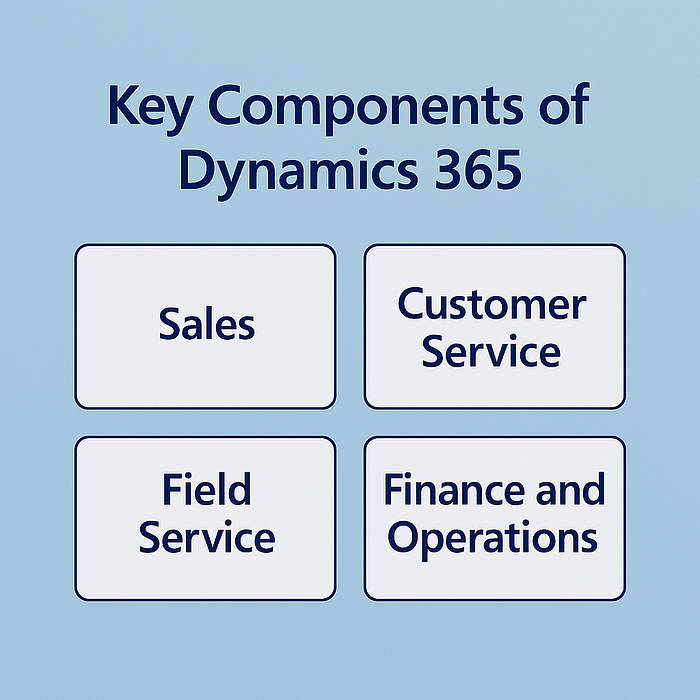Microsoft Dynamics 365: The Future of Intelligent Business Applications
Introduction
In today’s fast-paced digital landscape, businesses are under immense pressure to be more agile, data-driven, and customer-centric. That’s where Microsoft Dynamics 365 steps in — a powerful suite of intelligent business applications that seamlessly combines Customer Relationship Management (CRM) and Enterprise Resource Planning (ERP) capabilities. Whether you’re a small business looking to streamline operations or a global enterprise aiming to boost customer engagement, Dynamics 365 offers the flexibility and tools to drive transformation.
What Is Microsoft Dynamics 365?

Microsoft Dynamics 365 is a cloud-based platform launched by Microsoft in 2016. Unlike traditional software, it brings together multiple business functions — like sales, customer service, finance, operations, supply chain, and marketing — into a unified ecosystem. Built on Microsoft Azure, it integrates natively with familiar tools such as Microsoft 365 (formerly Office 365), Power BI, Power Apps, and Teams, enhancing productivity and collaboration across the board.
Key Components of Dynamics 365

Dynamics 365 is modular, meaning businesses can choose the apps that are relevant to their needs. Some of the most popular modules include:
- Dynamics 365 Sales — Empower sales teams with AI-driven insights, predictive lead scoring, and customer relationship tracking.
- Dynamics 365 Customer Service — Deliver exceptional support through omnichannel service capabilities and knowledge management.
- Dynamics 365 Finance — Automate and streamline financial operations, gain real-time visibility into financial performance, and ensure regulatory compliance.
- Dynamics 365 Supply Chain Management — Optimize inventory, manufacturing, and logistics with real-time data and intelligent automation.
- Dynamics 365 Marketing — Personalize campaigns, manage leads, and automate marketing journeys with seamless integration to sales.
- Dynamics 365 Human Resources — Manage the entire employee lifecycle from hiring to performance tracking and payroll integration.
Why Businesses Choose Dynamics 365

1. Cloud-first flexibility
Dynamics 365 is built for the cloud, ensuring scalability, mobility, and automatic updates. It allows teams to access critical data and insights from anywhere.
2. Deep integration with Microsoft tools
Because it’s part of the Microsoft ecosystem, Dynamics 365 works effortlessly with tools like Excel, Outlook, and Teams, making it easy for users to adopt and stay productive.
3. AI and analytics at its core
With embedded AI capabilities and real-time analytics via Power BI, businesses can make informed decisions, forecast trends, and uncover hidden opportunities.
4. Customization and extensibility
Dynamics 365 supports low-code/no-code development through Power Platform, enabling businesses to build custom apps, automate workflows, and adapt the system to their specific processes.
5. Security and compliance
Hosted on Microsoft Azure, Dynamics 365 offers enterprise-grade security, data protection, and compliance with global standards like GDPR.
Join Now to Access More information
Real-World Use Cases
- A retail company can integrate Dynamics 365 Commerce and Supply Chain to create a unified shopping experience and improve inventory management.
- A healthcare provider can use Dynamics 365 Customer Insights to offer personalized patient engagement and streamline appointment scheduling.
- A manufacturing firm can benefit from predictive maintenance powered by AI, reducing downtime and operational costs.
Final Thoughts
Microsoft Dynamics 365 isn’t just software — it’s a digital transformation enabler. By bringing together operational data, customer interactions, and AI insights, it empowers businesses to make smarter decisions and build stronger relationships. Whether you’re starting small or scaling globally, Dynamics 365 adapts to your needs and grows with your vision.
In a world where adaptability and insight are keys to success, Dynamics 365 helps businesses not just keep up — but lead.

Comments
Post a Comment